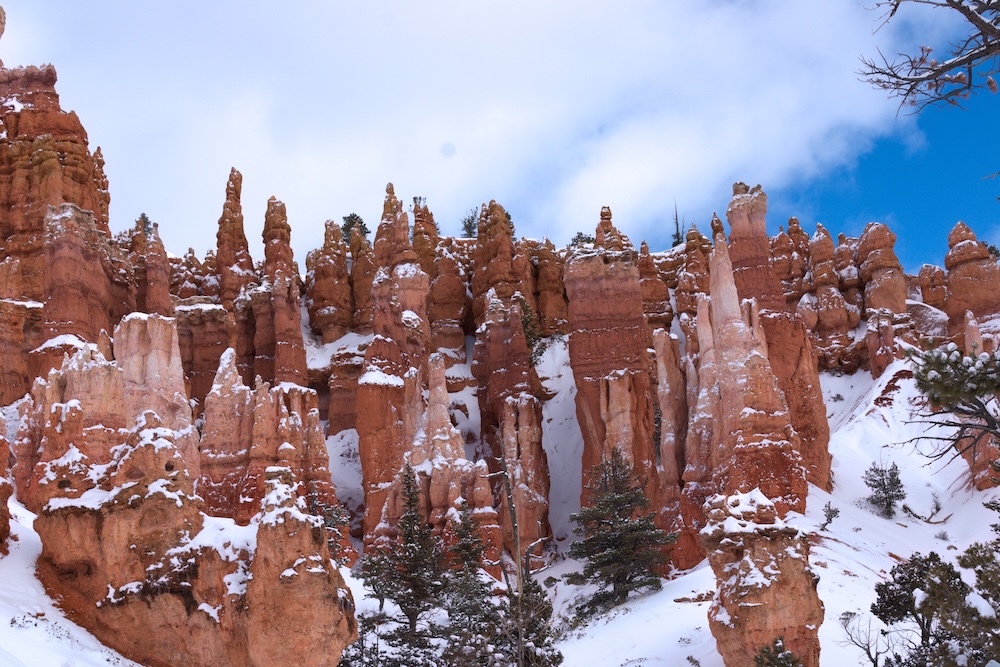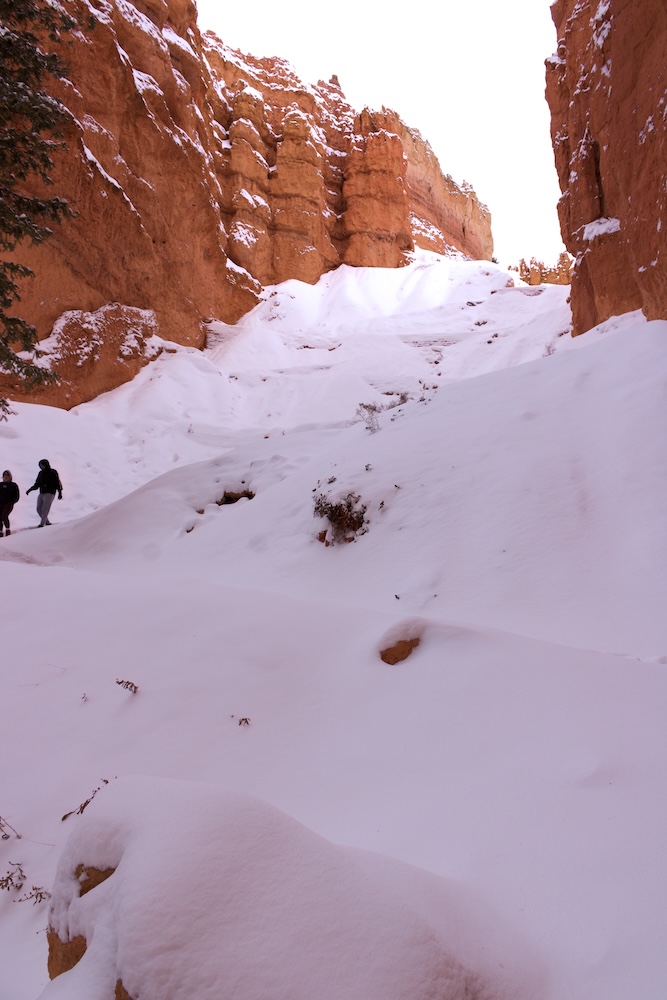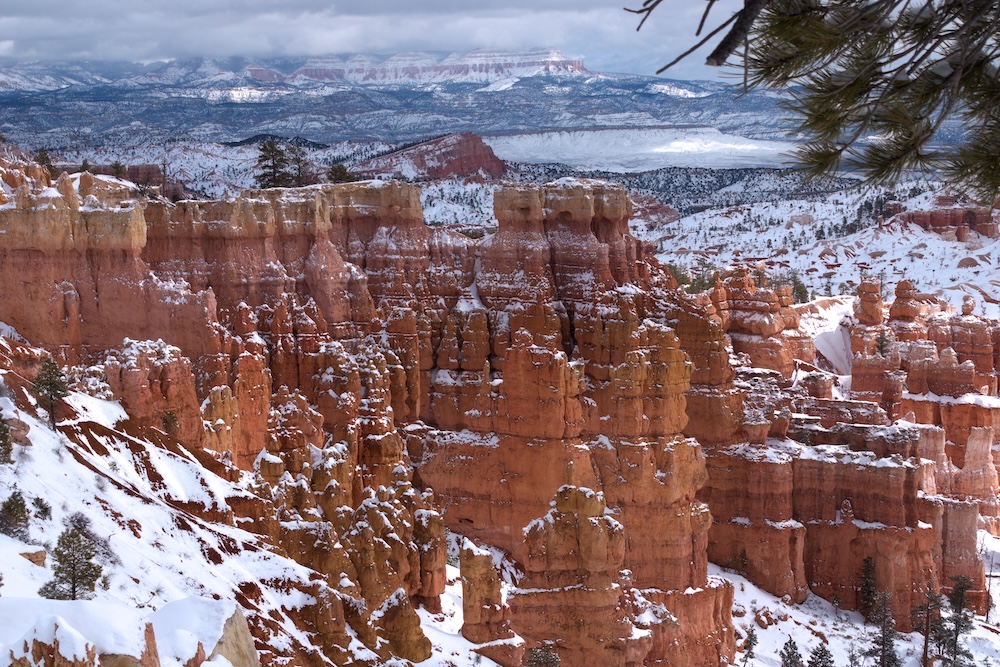Bryce Canyon National Park is spectacular with its iconic hoodoos littering the bottom of the canyon. While it’s cool to take in the views from the rim (you’ll find so many incredible view points), another fantastic option is to hike into the canyon. Through most of the year, you can do this without too much extra thinking. However, if are planning a Bryce Canyon winter hike, you’ll need to take some extra precautions.
This guide is specifically made for those looking to hike the Navajo Loop/Queen’s Garden Trail at Bryce Canyon National Park during the winter months. While some of the experience can apply to all times of the year (such as the direction of travel), I’ll be heavily focusing on my experience hiking during winter.

About Bryce Canyon National Park
Bryce Canyon National Park is part of Utah’s Mighty Five. The canyon sits in southwestern Utah and is famous for its hoodoos. So what is a hoodoo? It’s a thin rock spire. There’s a handful of places in the world where you can find them. Bryce Canyon is obviously one of these places but you can also find hoodoos in Utah’s Goblin Valley State Park, some areas of New Mexico, and the Cappadocia region of Turkey.
Tips for a Bryce Canyon Winter Hike
First, check the National Park Service website, for what to expect during the month you plan to visit. You can do this during the planning stages of your trip.
Next, as you get closer and closer to your trip, check reviews on AllTrails. You’ll want to look at the most recent reviews to see what people are saying about the condition of the trail. Is it muddy? Is there snow? There’s no guarantee that these will be the conditions that you are hiking in, but you may start to notice a theme. Have people been talking about mud and snow for the last two weeks? There’s a very good chance that’s what you’ll have on your visit.
Third, before you start your hike, stop at the Visitor Center and talk to the rangers. They’ll have the most up to date information. During my visit, the rangers were telling people that they couldn’t stop people from hiking into the canyon, but they were advising against it unless you had micro spikes or crampons.
I had read advice before my trip and purchased a set of micro spikes on Amazon just in case. The store at the Visitor Center does sell micro spikes, but they are more expensive than what you’ll find on Amazon (I got mine for less than $15, and at the Visitor Center they were about $30+). I’ve also read that you can rent crampons from Ruby’s Inn, but since I had my own micro spikes, I didn’t need to use that option. Plus, from what I’d read, based on what’s you’ll pay for the rental, you could spend an extra $5 and order your own pair from Amazon.

What’s a Bryce Canyon Winter Hike Actually Like?
So what’s it like to actually hike into Bryce Canyon in the winter? Well, first you need to understand that conditions are varied. There may be snow, there may be ice, or there may not be. My recommendation is to prepare yourself for all situations as best as you can.
So given all that, what was the hike like? Well, it was snowy, at least on my visit. When I hiked, there was about 3 to 4 inches of fresh snow on the trail.
I had both micro spikes and hiking poles and I felt secure. It never felt slippery and that is great peace of mind. I got to be confident in every step I took. I’d argue though, that only the micro spikes were necessary, but it was still nice to have the hiking poles. So if you’re debating between hiking poles or micro spikes, I’d say micro spikes.
Now that said, I passed plenty of people on the trail who didn’t have micro spikes or hiking poles. So it is possible (at least on certain days) to hike without micro spikes or hiking poles. But I can say that they did not have as secure footing and did slip and slide a bit on the snow. So, if possible, I’d recommend purchasing your own spikes or renting them if you don’t have your own.
My other piece of advice is to do the trail counter clockwise. I started down the Navajo Loop, crossed the bottom of the canyon, and hiked back up the Queen’s Garden Trail. This is what the rangers recommend, but it’s also my recommendation as well. The Navajo Loop is steeper and I think it’s a lot easier to hike than going down. As you climb out of the canyon, the Queen’s Garden Trail has a longer ascent, but it’s more gradual. I think this is especially better when you’re hiking in the snow.
So was it cold? It was cold the day I hiked, but honestly, I didn’t feel the cold much as I was hiking. There were strong winds in the area for three of the four days on my trip. At some of the view points, particularly Bryce and Inspiration Points, the wind was so strong and chilled you right to the bone. Inside the canyon, I hardly noticed the wind. The canyon walls offered fantastic protection.
That all said, I hiked with my warmest leggings and a pair of joggers over the top. For my top layer, I had a long sleeve t-shirt, a fleece, my puffy jacket, and a wind/rain jacket. Yes that seems excessive, but I felt comfortable during my entire hike. I never felt cold, but I never felt very hot either. And of course, I also had a hat and gloves.

Should You Hike Bryce Canyon in the Winter?
The choice is ultimately yours. I think if you take the proper precautions it’s still possible to hike Bryce Canyon in the winter months. That said, if there’s an active snow storm, I’d suggest to wait until the snow finishes. When in doubt, ask the rangers for advice.
How Long Do You Need at Bryce Canyon National Park
Honestly, I think you can get away with only budgeting a half day at Bryce Canyon. Sure, you could really take your time at each view point, or do some other hikes into the canyon, but I think at most, one day is plenty for Bryce Canyon.
If you choose to do a half day at Bryce Canyon, consider combining it with one of the other amazing parks nearby. You could visit Grand Staircase Escalante National Monument, Zion National Park, or Capitol Reef National Park. Plus, there are also a handful of state parks nearby as well.
No matter if you spend the full day at Bryce Canyon National Park or split your day with one of the other nearby parks, you’ll be sure to have a good time.

Where to Stay at Bryce Canyon National Park
Bryce Canyon City sits just outside of Bryce Canyon National Park. You’ll find the Ruby’s Inn hotel, a handful of restaurants, a general store, gas station, and Bryce Canyon Shuttles (operating seasonally and closed in winter). Admittedly, it’s going to cost a bit more to stay here as it’s literally the only hotel in town, but if you can limit your visit to just one night, it’s not as bad. Plus, you are so close to the entrance of the park, making it easy to visit for sunrise and/or sunset.
If Bryce Canyon City is out of your price range, you’ll have to stay a bit further away. The town of Panguitch, UT is a 25 minute drive away and has a few budget hotel options.
When to Visit Bryce Canyon National Park
It is possible to visit Bryce Canyon National Park all year round, but some seasons are better than others. Summers are the warmest, but also the busiest. Expect high prices and lots of other tourists.
Winter is the opposite. Crowds are at their lowest, but the weather is the coldest. Don’t be surprised to encounter snow on your visit. While the snow may not prevent you from hiking into Bryce Canyon, it can prevent you from seeing some of the view points. If there’s snow, parts of the scenic drive can close, leaving very limited options. On my visit, snow closed the scenic drive and only four view points were accessible.
Spring and fall can help you strike a balance between crowds, prices, and weather. If I had to pick any season to visit, I’d choose fall.

My Visit(s) to Bryce Canyon National Park
I’ve visited Bryce Canyon National Park twice. My first visit was in October, and although the weather did not cooperate, I’d still recommend this time of year. The rest of my trip to Utah had absolutely perfect weather (I just happened to visit Bryce Canyon on the one day it rained). If you also have crappy weather during your visit, specifically rain and fog, don’t be surprised if you don’t fall in love with Bryce Canyon. It’s difficult to appreciate when you can’t really sense the scale of this magnificent canyon.
My second visit was all about redemption, but I still ran into some weather issues. It had snowed the day before I visited, so I hiked through Bryce Canyon in about 3 to 4 inches of snow. While that wasn’t ideal, it wasn’t bad since I had packed my hiking poles and a set of micro spikes. However, the snow closed most of the scenic drive. Visitors were able to visit Sunrise and Sunset Points, as well as take the road to Inspiration and Bryce Points, but beyond that, the road was closed.
So while I wasn’t able to visit everything I wanted to at Bryce Canyon, I’d have to say that my second visit was much better than my first. However, in both instances, I was able to cover everything I had planned to do that day with just a half day.
Final Thoughts
I waited two and a half years to hike into Bryce Canyon. On my first visit to Bryce Canyon, there was rain and fog and we just called off the hike. So on my second visit, I knew I had to hike in, regardless of the weather. Well, that meant that I was hiking through the snow. I moved slower than I would have normally, but it was an amazing experience. I’d recommend sticking to visiting Bryce Canyon during the non winter months just because I think the hiking is more pleasant, but it’s still totally doable for visitors during the winter, so long as you are prepared.
Continue Your Adventure
Bryce Canyon: One day is all you need to see the highlights of Bryce Canyon. If it rains on your visit to Bryce Canyon, learn how to make the most of your day. If you’re planning a winter visit, don’t forget to check out my top winter travel tips.
More in Utah: Bryce Canyon is just one of Utah’s “Mighty Five”. Stop by Arches National Park for the iconic delicate arch. Canyonlands National Park features other worldly scenery. Capitol Reef National Park has canyons and arches and feels less visited. Zion National Park is just jaw dropping and has so many good hikes. Beyond the national parks, don’t forget the state parks such as Snow Canyon State Park.
Itineraries: You can’t go wrong with my 10 Day Utah National Park road trip, which features all of Utah’s “Mighty Five”, the Grand Canyon, and Monument Valley. For those with less time, check out my 5 Days in Zion and Bryce itinerary.
US National Parks: Start planning your national park vacation with my US National Park Travel Guide. You’ll find information about each park, photos, itineraries, budget tips, advice for non-hikers, the best scenic drives, and more. Plus, don’t forget to book your timed entry reservations in advance!
